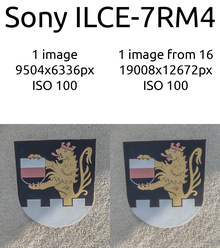

This article needs additional citations for verification. Please help improve this articlebyadding citations to reliable sources. Unsourced material may be challenged and removed.
Find sources: "Pixel shifting" – news · newspapers · books · scholar · JSTOR (January 2023) (Learn how and when to remove this message) |
Pixel shifting refers to various technical methods, either to diminish damage to displays by preventing "burn in" of static images or to enhance resolution of displays, projectors, and digital imaging devices. The term is often used synonymously with the more specific term pixel shift.
See Pixel shifting avoids burn-in explained in detail for both analogue and digital screens.
Computer terminals such as the HP 2645A used a half-shift algorithm to move pixel positions by half a screen pixel in order to support the generation of multiple complex character sets.[1]
Pixel shifting has been implemented in video projectors to expand the native 1080p resolution to produce an effectively 4K image on the screen. An exemplary implementation by the electronics corporation JVC is referred to as "e-shift".[2]

Pixel shifting by movement of one or more sensors is a technique to increase resolution[3] and/or colour rendering[4] of image capturing devices.
Some camcorders and digital microscopes employ separate color channel sensors (usually RGB = red, green, blue) sensors.
Currently most consumer imaging devices (cameras, camcorders, smartphones) employ a single multi colour channel sensor, on which the RGB (red, green, blue) pixels are usually arranged in a Bayer pattern. Thus any mode of pixel shifting movement either by fractional or by whole pixel values, whether to obtain a more detailed image or to improve tonal resolution, must necessarily engage the whole sensor.